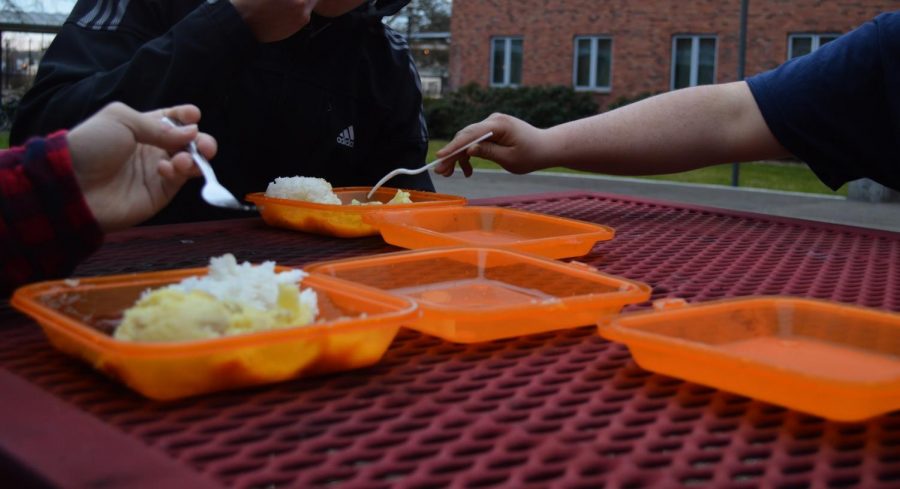Sustainability efforts at OSU receive national attention
February 6, 2017
Reuseable Eco2go program has diverted over 400,000 single-use containers
Oregon State University’s sustainability efforts have gained national attention.
The Sustainability, Tracking, Assessment and Rating System gave OSU a gold rating in 2016. This is a general rating system that covers all of the school’s sustainability efforts.
From implementing Eco2Go containers to reducing greenhouse gas emissions, the dining services team is doing what it can to help the environment. OSU Sustainability Officer Brandon Trelstad has held and developed his position for over 11 years, and believes preserving resources for the future is absolutely critical.
“Allowing future generations to meet their needs while we meet the needs of
today,” Trelstad said.
In fall term of 2015, UHDS made a significant push toward a more sustainable campus with the use of Eco2Go containers. These reusable containers replaced disposable containers, and bins were set up around campus for the Eco2Go containers to be deposited in and later washed.
These unique efforts gained national recognition, leading to inquiries from other colleges about how OSU implemented such a successful program in such a short amount of time. According to Anderson, schools like Dartmouth and the University of Washington came calling to find out how OSU’s reusable container program worked so well. Anderson estimates that these Eco2Go containers have diverted the use of 400,000 single use containers since its beginning.
Despite the Eco2Go containers success they are currently only used within UHDS, but it is possible that the rest of the university could get involved. Memorial Union Retail Food Services currently uses compostable utensils and containers.
According to Robyn Jones, assistant director of MURFS, many of the MURFS restaurants are grab and go style, so these containers might not be as practical. Jones also cited the cost of implementing Eco2Go containers and the physical shape of the containers not fitting each restaurant as other reasons why MURFS does not use reusable containers.
“(At) North Porch (Cafe), we use these specific bowls and we don’t feel like the rice bowls we offer would work well in those containers,” Jones said.
However Jones is not ruling out the possibility of MURFS using Eco2Go containers in the future.
“(MURFS) would look at partnering with UHDS and then they would pick (the Eco2Go containers) up, wash them and then redeliver them,” Jones said. “But they would want to recoup their cost.”
Chris Anderson is the assistant manager for dining services, and says UHDS is also working specifically on reducing waste. The dining halls, Bing’s Cafe, Cascadia Market, 541, Pete’s Coffee and OSU Catering are all run by UHDS. At each of these locations, UHDS’s goal is to throw away as little as possible.
Anderson cites the restaurant 541 as being the “greatest example of the values we stand for.”
This is due in part to the restaurant’s usage of all-natural ingredients. The pizza and pasta joint even occasionally uses ingredients grown a few dozen feet away in the Callahan food forest. UHDS is in the process of expanding the Callahan food forest and Tara Sanders, the assistant director of nutrition and sustainability, said the expansion is about students learning about the food they eat and “(showcasing) the food that we serve our customers.”
Other than the food forest, much of the dining halls’ food comes from within a 100 mile radius. UHDS uses exclusively grass-fed beef from Oregon and all dairy products are from Eugene. The flour used in pizza crusts comes from the Eugene-based distributor Hummingbird Wholesale.
“(We want to) support local environment and community,” Sanders said.
One of UHDS’ slogans is “food you can feel good about,” and Anderson’s passion for the department’s efforts shines through.
“It’s really our mission to serve the highest quality food at the best possible value to specifically our residents. This is the food that is going to make students more likely to persist towards graduation. We are a non-profit, our goal is not necessarily to be paying shareholders, it’s to make students more successful,” Anderson said.
The sustainability efforts are constantly progressing with each year’s additions of new technology. They use low flow water faucets and LED lighting. The restaurants utilize small batch cooking to avoid making more food than people will eat. Waste is managed by composting it, and this past summer UHDS got some new technology to help make this
process more efficient.
“(It) goes into a big shredder, kind of like a large garbage disposal, that centrifuges all of the water out so it’s just leaving the dried organic materials so we can fit a lot more into our compost bins,” Anderson said.















































































































